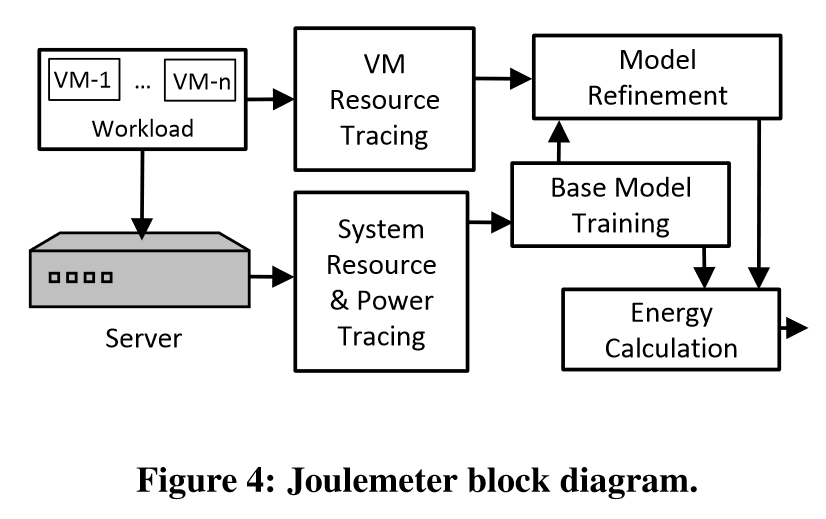Virtual machine power metering and provisioning
Status:: 🟩
Links:: Measure energy consumption of server-side applications and cloud-based systems
Metadata
Authors:: Kansal, Aman; Zhao, Feng; Liu, Jie; Kothari, Nupur; Bhattacharya, Arka A.
Title:: Virtual machine power metering and provisioning
Date:: 2010
Publisher:: Association for Computing Machinery
URL:: https://dl.acm.org/doi/10.1145/1807128.1807136
DOI:: 10.1145/1807128.1807136
Bibliography
Kansal, A., Zhao, F., Liu, J., Kothari, N., & Bhattacharya, A. A. (2010). Virtual machine power metering and provisioning. Proceedings of the 1st ACM Symposium on Cloud Computing, 39–50. https://doi.org/10.1145/1807128.1807136
Zotero
Type:: #zotero/conferencePaper
Keywords:: [Measurement, Performance, Green IT, Software Operation, Virtualization]
Relations
Abstract
Virtualization is often used in cloud computing platforms for its several advantages in efficiently managing resources. However, virtualization raises certain additional challenges, and one of them is lack of power metering for virtual machines (VMs). Power management requirements in modern data centers have led to most new servers providing power usage measurement in hardware and alternate solutions exist for older servers using circuit and outlet level measurements. However, VM power cannot be measured purely in hardware. We present a solution for VM power metering, named Joulemeter. We build power models to infer power consumption from resource usage at runtime and identify the challenges that arise when applying such models for VM power metering. We show how existing instrumentation in server hardware and hypervisors can be used to build the required power models on real platforms with low error. Our approach is designed to operate with extremely low runtime overhead while providing practically useful accuracy. We illustrate the use of the proposed metering capability for VM power capping, a technique to reduce power provisioning costs in data centers. Experiments are performed on server traces from several thousand production servers, hosting Microsoft's real-world applications such as Windows Live Messenger. The results show that not only does VM power metering allows virtualized data centers to achieve the same savings that non-virtualized data centers achieved through physical server power capping, but also that it enables further savings in provisioning costs with virtualization.
Notes & Annotations
📑 Annotations (imported on 2023-06-26#12:00:11)
Power management requirements in modern data centers have led to most new servers providing power usage measurement in hardware and alternate solutions exist for older servers using circuit and outlet level measurements. However, VM power cannot be measured purely in hardware. We present a solution for VM power metering, named Joulemeter.
The use of virtual machines (VMs) comes with many benefits such as safe isolation of co-located workloads, enabling multiple workloads to be consolidated on fewer servers, resulting in improved resource utilization and reduced idle power costs.
Infer energy from resource usage: We can, in principle, track the resources used by each VM in software and then convert the resource usage to energy by leveraging the power models of individual resources.
For this approach, we need to track the usage for all the hardware resources, such as the CPU cores, disk arrays, memory banks, network cards, and graphics cards, to determine what power level the resource was operating at and what VM was it working for.
The largest dynamic energy consuming resources in a computer server (without displays) are the processor, memory, and disk. The server of course has a non-trivial idle energy consumption, often exceeding 50% of its peak power, but the idle energy is relatively static and can be measured in hardware. The energy impact of the VM can thus be considered in terms of the dynamic energy used.

The system is implemented using Windows Server 2008 R2 HyperV but the concepts extend to other hypervisors as well.
Providing visibility into energy use is often a valuable motivator for developers to redesign their applications for saving energy. While developers can measure the energy use on their developer workstations or in-house servers, by connecting hardware power meters, they do not have that visibility on the actual cloud servers, where the VM behavior could be different due to differences in processor micro-architecture, cache hierarchies, or IO speeds. Joulemeter can provide energy visibility for individual workloads, even on a shared cloud platform.
We presented a VM power metering approach that can be implemented on current virtualized platforms without adding any additional hardware or software instrumentation. The guest VMs are not modified and existing hardware capabilities are used. We addressed the challenges involved in obtaining a low estimation error for cloud scenarios with several different types of workloads sharing the same hardware. Our solutions also adapts to changes in workload characteristics and hardware configurations. The end result is a mechanism that extends the current physical server power monitoring solutions to VM power monitoring.